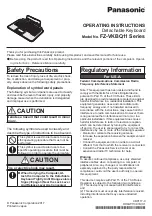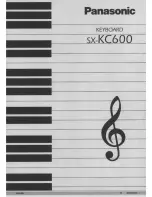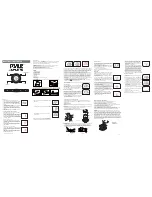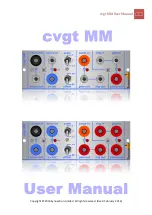
Next, the upper readout will show SG (Subgroup). Enter
the appropriate subgroup. For this example, 0.
Now the upper readout will show P (Parameter), so enter
the parameter number. The parameter number for Op. 6
Frequency Fine is 13 (Hexdecimal).
Now go back to CA mode and assign Controller Code 41
to a controller, for example CS3. Then, go to PLAY
mode and try out the new assignment you have made.
As you move the slider, the harmonic structure of the
sound should change interestingly.
Controller Code 42 = Feedback
Controlling the amount of feedback (in a DX synthesizer
operator) using Aftertouch is also interesting.
Enter PA mode.
Press PARAMETER CHANGE.
Enter the controller code you want to define. (42)
Assign the limit. The DX series feedback has a range of
0 to 7. So, press bank B switch 2 to select a limit of 7.
(For details, see page 28)
Now enter the group. number for the parameter you
want. (See the DX7 MIDI data list on page 00) In this
case, 00.
Enter the subgroup. In this case, 0.
Enter the parameter number. In this case, 07.
Go back to CA mode and assign controller code 42 to
Aftertouch. Then, go to PLAY mode and try it out.
Try using a voice that normally does not have very much
feedback. When you press down on the keyboard, the
sound will become much brighter.
Controller Code 43 = Op. 6 Keyboard
Level Scaling Break Point
The idea of this assignment is to use a Foot Controller to
move the break point up and down the keyboard. If the left
and right level scaling depth is set rather high (-LIN), and
if this operator is a modulator, you will get a very strange
“Wah” effect swept up and down the keyboard. Anyway,
let’s give it a try.
Enter PA mode.
Press PARAMETER CHANGE.
Enter the controller code. (43)
Assign the limit. Keyboard Level Scaling Break Point has
a range of 0 to 99. So press bank B switch 6 to set a
limit of 99.
Enter the group number. (00)
Enter the subgroup number. (0)
Enter the parameter number. (Op. 6 Keyboard Level
Scaling Break Point is 08)
Go back to CA mode and assign controller code 43 to
FC2. Then, go to PLAY mode and try it out. The effect
will change depending on the voice, especially Op. 6
output level and level scaling settings.
Experiment with it.
Controller Code 44 = PITCH EG Level 1
Here’s another interesting setting. It’s especially effective
if you enable it for only one MIDI bank.
Enter PA mode.
Press PARAMETER CHANGE.
Enter the controller code. (44)
Set the limit. PITCH EG Level 1 has a range of 0 to 99,
so press bank B switch 6 to choose a limit of 99.
Enter the group number. (00)
Enter the subgroup number. (1)
Enter the parameter number. (Pitch EG Level 1 is 02)
Go back to CA mode and assign controller code 44 to
CS3. (Disable bank B) Then, go to PLAY mode and try
it out. It will help if you set Pitch EG Rate 2 to a
moderate rate (about 20) When you hit a note, the two
tone generators will at first be dissonant, and then
slowly resolve. Use CS3 to adjust the amount of effect.
(In center position, no effect.)
By now you should have a fairly good idea of the
possibilities of the KX88. It is important to keep a
record of the settings you have made, and we suggest
that you copy and use the form on page 00. If you have
been following all the examples, the form would look
like this.
- 1 9 -
Summary of Contents for KX88
Page 1: ...YAMAHA AUTHORIZED PRODUCT MANUAL MIDI MASTER KEYBOARD ...
Page 2: ...YAMAHA MIDI MASTER KEYBOARD OWNER S MANUAL ...
Page 23: ...KX88 BLOCKDIAGRAM 21 ...
Page 27: ...BINARY DECIMAL AND HEXADECIMAL CONVERSION Conversion Table 25 ...
Page 34: ...KX88 CONTROLLER ASSIGN TABLE SET NAME USER NAME CREATE DATE 3 2 ...
Page 37: ...SINCE 1887 YAMAHA NIPPON GAKKI CO LTD HAMAMATSU JAPANt ...
















































